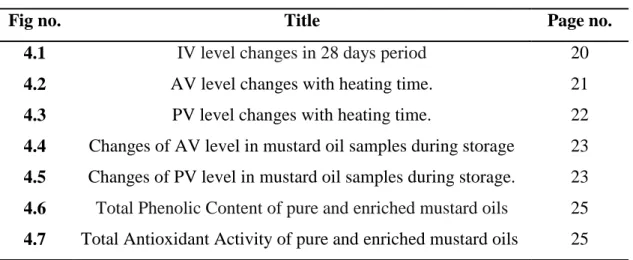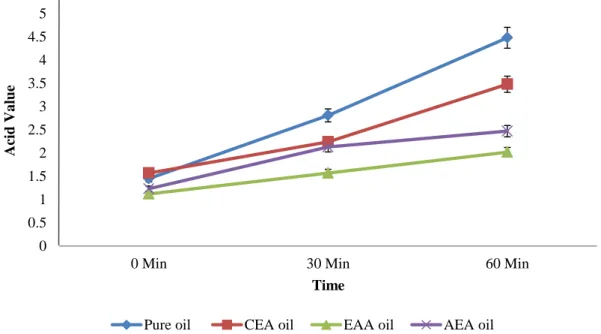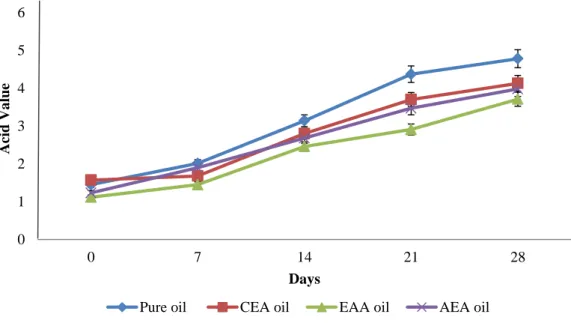Effects of spice and herbal extracts on the thermal and storage stability of mustard oil. This is to report that according to the audit …….% of the content of the above dissertation has been plagiarized and may or may not be covered under the Plagiarism Policy and Institutions issued by CASR, Chattogram Veterinary and Animal Sciences University. Firstly, I would like to express my deepest feelings for the "Almighty Allah" whose blessings have enabled me to successfully complete the research work and dissertation in this field and to write this dissertation for the degree of Master of Science (MS ) in the Department of Food Processing & Engineering.
Ashraf Ali Biswas, Dean, Faculty of Food Science and Technology, CVASU, for providing the necessary scale and funding to carry out the work throughout the period.

Abstract
Introduction
Mustard oil can be produced from black mustard (Brassica nigra), brown Indian mustard (Brassica juncea) and white mustard (Brassica hirta). Several groups of spices and herbs can be identified based on their taste or flavor and the part of the plant from which they originate. To investigate the antioxidant activity of extracts of spices and herbs when used in mustard oil.
To assess the storage stability of fortified mustard oil by monitoring changes in its peroxide value, acidity and oxidative stability over a period of time.
Review of Literature
- Oils and Fats
- Synthetic antioxidants
- Edible oil and natural extract
- Herb and spices
- Asafoetida
- Clove
The antioxidant and antimicrobial properties of phenolic compounds found in plants have become a popular topic of study in recent years (Bubonja-Sonje et al., 2011). Microencapsulated high-oleic sunflower oil has been shown to benefit the antioxidant properties of extracts from four different natural plants (rosemary, broccoli sprouts, and citrus) (Ahn et al., 2008). when treated with these natural plant extracts. The antioxidant effects of hazelnut and poppy oil were also studied and compared with the effects of butylated hydroxyanisole (BHA) and essential oils of rosemary (Rosmarinus officinalis), cloves (Syzygium aromaticum) and cinnamon (Cinnamomum zeylanicum) (Ozcan and Derya, 2011). ).
These results showed that the concentration of natural antioxidants significantly increased the efficiency of the antioxidant activity. Researchers in a separate study determined whether the antioxidant activity of a sesame methanol extract improved the stability of soybean, sunflower, and safflower oils (Suja et al., 2004). The antioxidant activity of herbs and spices is most often due to phenolic acids (gallic, protocatechuic, caffeic and rosmarinic acids), phenolic diterpenes (carnosol, carnosic acid, rosmanol and rosmadial), flavonoids (quercetin, catechin, na , gallate, epigallocatechin gallate and rutin) , volatile oils (eugenol, carvacrol, thymol, menthol, safrole, 1,8-cineole, α-terpineol, p-cymene, cinnamaldehyde, myristicin and piperine) and phenylpropanoids (thymol, carrolugenol , p-cymene) (Kapadiya et al. , 2016).
This relationship is reciprocal as it results in an increase in the antioxidant content of fruits. Cloves have been shown to effectively neutralize cancer-causing free radicals thanks to the antioxidant properties it possesses. According to the results of some studies, the antioxidant capacity of different types of clove products varies.
Eugenol, the primary component of cloves, is responsible for many of the antioxidant properties the oil possesses (Ogata et al., 2000). It is possible that the antioxidant activity is mediated by several mechanisms, such as radical scavenging and metal ion chelation.
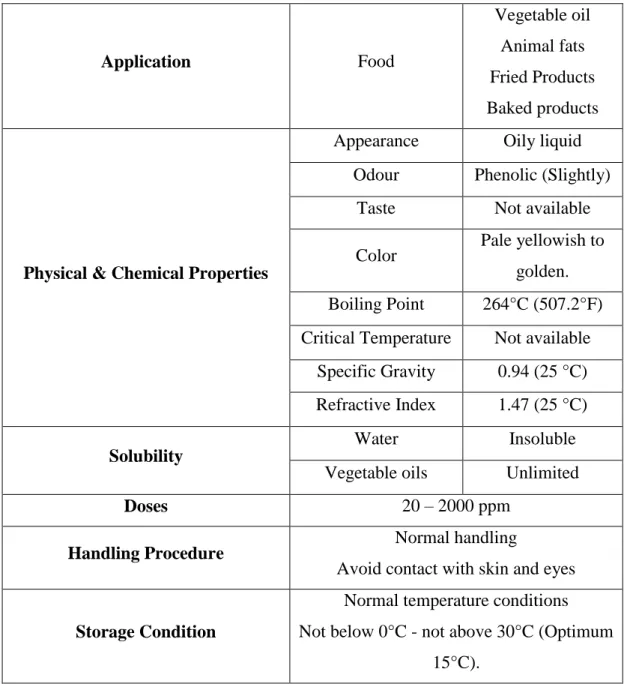
Materials and Methods
Purchase of Raw Material
Extraction from Spice & Herbs
Addition of Extracts to Oil
Determination of Physicochemical Properties of Oils .1 Acid Value (AV)
- Iodine value (IV)
- Specific Gravity
- Moisture Content
It is defined as the amount of peroxide oxygen per 1 kg fat or oil. It provides a measure of the extent to which an oil sample has undergone primary oxidation. The method for determining PV involves a titration of the oil containing potassium iodide in a mixture of chloroform and acetic acid. Then placed in a dark place for 5-10 minutes and then added 30 ml of distilled water. Approx. 1-2 drops of lightly boiled starch indicator were added.
Specific gravity or relative gravity is a dimensionless quantity defined as the ratio of the density of a substance to the density of water at a specified temperature. After letting the item soak for 30 minutes, you took it out, dried it with a towel, and weighed it. Removed the cap from the side arm of the pycnometer before using it on the prepared oil sample and filled the instrument without trapping any air bubbles.
Place the sealed container in a water bath preheated to 30 °C and leave for 30 minutes. When the temperature drops below 30 °C, quickly remove the cap from the side arm and quickly weigh it. Moisture content (or water content) refers to the weight of water contained in a particular object or material.
Then the lid of the dish was loosened and heat was applied in an oven at 105°C for 1 hour. W1 = Loss in gm of the material on drying W = Weight in gm of the material taken for testing.
Determination of Thermal Stability of enriched Oil
Weigh out 5–10 g of oil or fat that has been well mixed by stirring into a dish that has already been dried and tarred.
Determination of Oxidative Stability of enriched Oil
Determination of Biochemical Properties of Oils .1 Total Phenolic Content of Oil
- DPPH Radical Scavenging Activity (Antioxidant Assay)
Statistical Analysis
Result
- Physicochemical Properties of Oil
- Thermal Stability
- Oxidative Stability
- Total Phenolic Content
- Total Antioxidant Activity
Since the p-value of all the samples in both scenarios was less than 0.05 (p < 0.05) and so it appears that the iodine value of pure and enriched oil samples has a significant difference. All the enriched and pure mustard oil samples used in this analysis had moisture levels ranging from 0.1% to 0.2% (Table 4.1). The p-value for all the samples was less than 0.05 (p < 0.05), which means that the sample was statistically significant.
According to the findings, the specific gravity of the enriched oils was higher than that of the pure oil, and the p-value of all the oil samples was lower than 0.05 (p < 0.05). In this experiment, with a calculated p-value of less than 0.05 (p . < 0.05), we can conclude that the AV of enriched and pure mustard oil samples has significant difference across all temperatures. Moreover, the statistically analyzed p-value of all oil samples was less than 0.05 (p < 0.05); therefore, there is a significant difference between the PV of enriched and pure mustard oil samples.
Since both pure and enriched oil samples had p-values less than 0.05 (p < 0.05), there was a significant difference between the AV levels of the enriched and pure oil samples. Since the p-value of pure and enriched oil samples from this study was less than 0.05 (p < 0:05) in all analyses, there was a significant difference between the PV of all samples. Different letters in superscript (a-c) in each row show statistically significant differences (p<0.05) for all samples.
Furthermore, the p value for all oil samples was less than 0.05 (p < 0.05) and this makes all oil samples statistically significant. Since the p-value in all oil samples was less than 0.05 (p < 0.05), the differences in antioxidant activity between enriched and pure mustard oil samples are statistically significant.
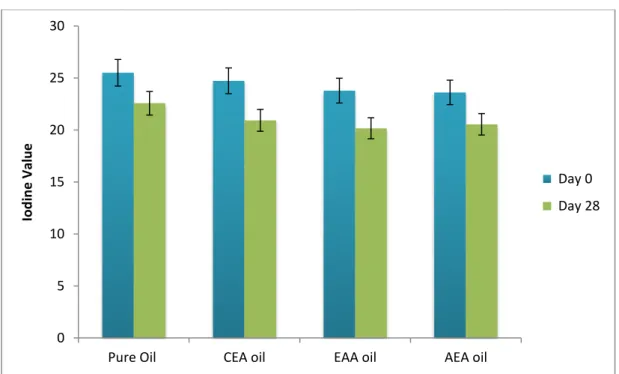
Discussion
- Changes in Physicochemical Properties of Oil
- Thermal Stability of natural and synthetic antioxidant rich oil
- Oxidative Stability of natural and synthetic antioxidant rich oil
- Total Phenolic Content of natural and synthetic antioxidant rich oil
- Total Antioxidant Activity of natural and synthetic antioxidant rich oil
The absence of free water in the diethyl ether base extraction is thought to be the main cause of this phenomenon (Shahrajabian et al., 2019). Some studies indicate that, when the temperature of the enriched oils was kept at 170 °C, the oils were found to exhibit improved stability and were less prone to rancidity (Chandran et al., 2017). Furthermore, when corn oil was infused with thyme extract and subjected to deep frying, that oil had the lowest peroxide value (Karoui et al., 2011).
According to some studies, oils with added essential oil or other bioactives have the lowest increase in peroxide value (Chandran et al., 2017). Robards et al reported that phenols have a direct relationship with antioxidant capacity, and Amarowicz and Pegg agreed that phenols are critical dietary antioxidants. Compared to other foods, spices and herbs have ten times more free radical scavenging capacity than fruits and vegetables (Yashin et al., 2017).
Some of the most important aspects that determine the effectiveness of an extract are the active materials found in the spices, the concentration and the process used to extract them (Dua et al., 2013). Furthermore, the availability of extracted lipophilic phenolic compounds can be related to better stability of oxidative nature of the treated oil samples (Žanetić et al., 2013). Since polar phenolic compounds are insoluble in fat, they do not dissolve in the oil, although other, more lipophilic, natural material components were dispersed (Taha et al., 2014).
Wang et al., conducted a study in which they used 45 different essential oils to detect antioxidant activity by analyzing the total phenolic content and DPPH free radical scavenging activity of the oils. Additionally, antioxidants can stop oil oxidation by acting as a reducing agent, a free radical scavenger and also a singlet oxygen scavenger (Shahid et al., 2018).
Conclusion
Recommendations and Future aspect
Oxidative stability, thermal stability and acceptability of coconut oil flavored with black pepper and ginger essential oils. Thermal stability of corn oil flavored with Thymus capitatus under heating and frying. Biochemical characterization of Mustard oil (Brassica campestris L.) with special attention to the fatty acid composition.
Antioxidant action of rosemary, clove and cinnamon essential oils on hazelnut and poppy oil. Determination of physico-chemical and functional properties of coconut oil by incorporating bioactive substances in selected spices. Chemical composition, antioxidant and antibacterial activity of the essential oil and methanol extracts of Eucalyptus largiflorens F.
Oxidative stability of fats and oils measured by differential linear calorimetry for food and industrial applications. Chemical constituents, antimicrobial investigations and antioxidant potentials of Anethum graveolens L. essential oil and acetone extract: Part 52. Use and stability of natural antioxidants in edible oils to replace synthetic additives.
DPPH free radical scavenging ability, total phenolic content, and chemical composition analysis of forty-five kinds of essential oils. Comparison of essential oil composition of Iranian fennel (Foeniculum vulgare) obtained by supercritical carbon dioxide extraction and hydrodistillation methods.
Appendices
Brief Biography
